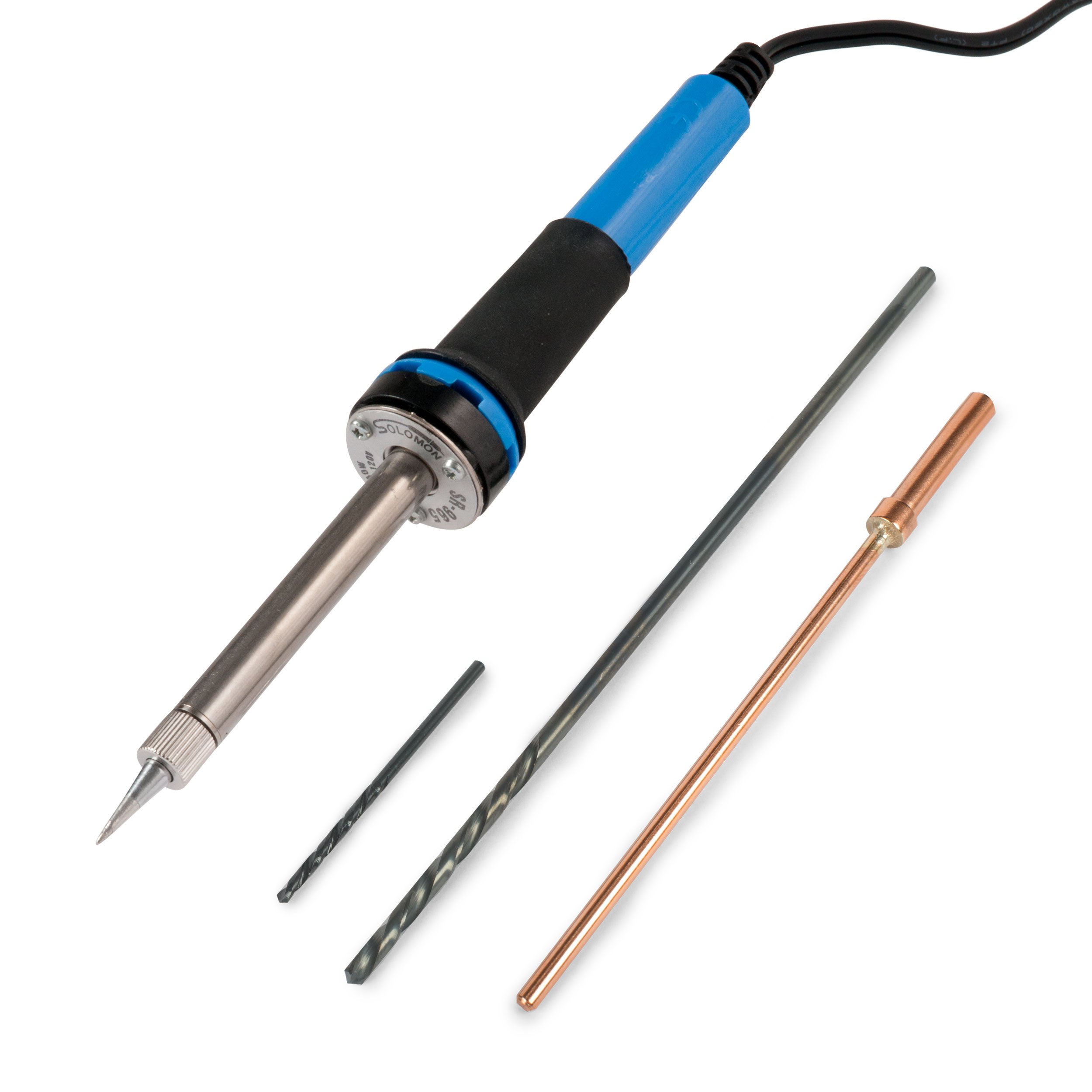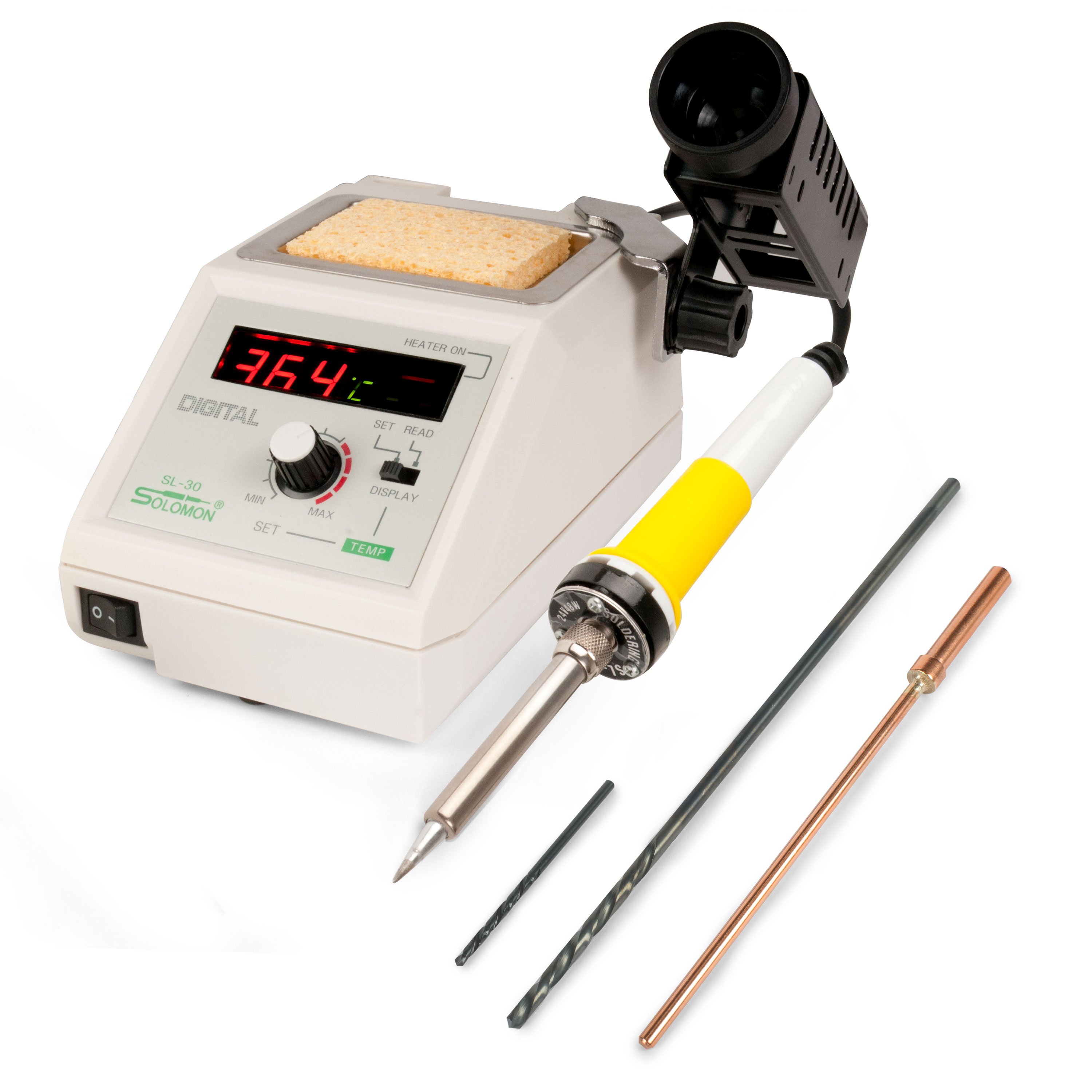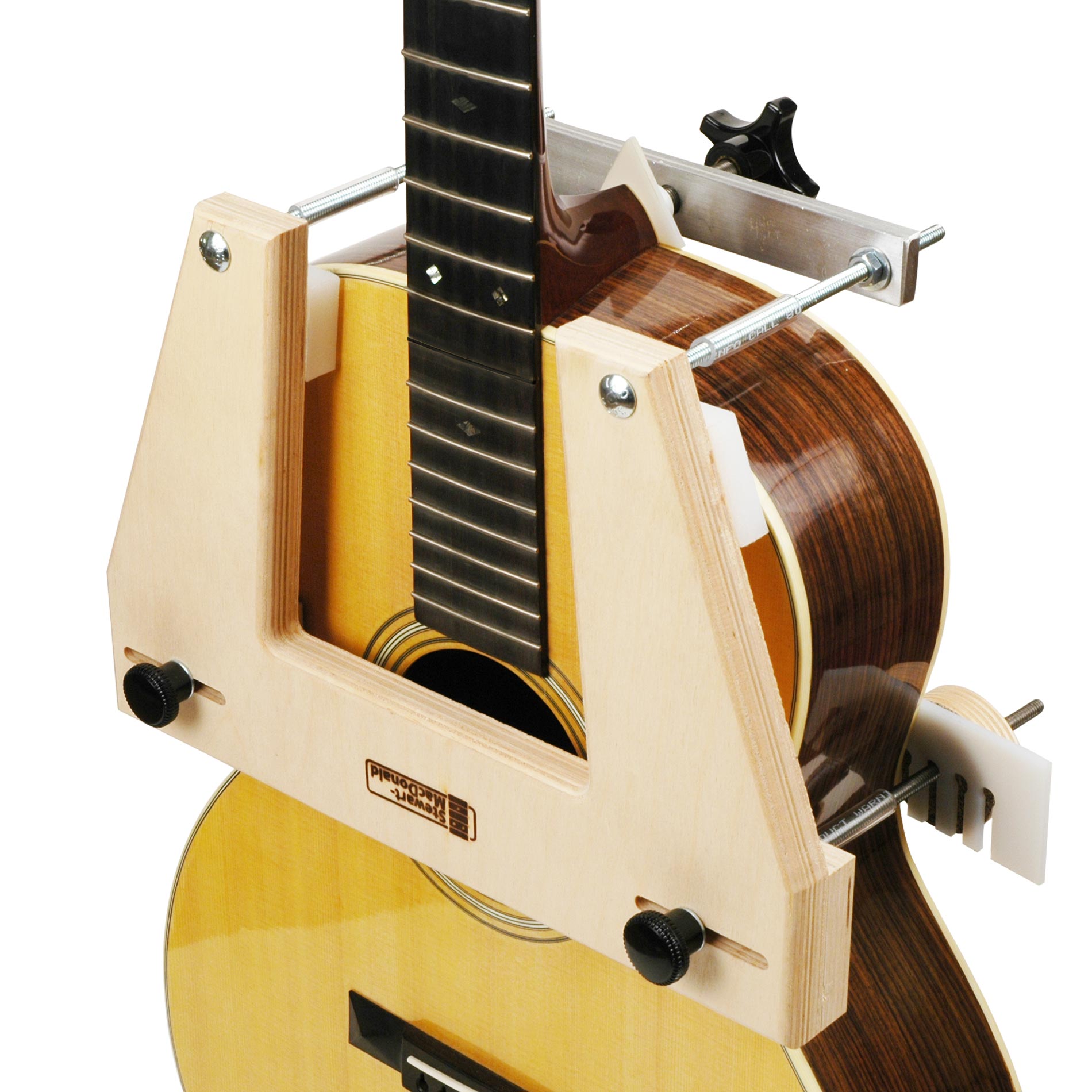StewMac HeatStick for Neck Removal
For removing glued guitar necks
The HeatStick™ is a tempered copper rod that uses the heat of your soldering iron to soften the glue in a guitar's neck joint. Used with our Neck Removal Jig or other neck-removal system, the HeatStick replaces the old method of injecting steam into the joint. This dry heat method doesn't subject delicate finishes to the damaging effects of hot steam.
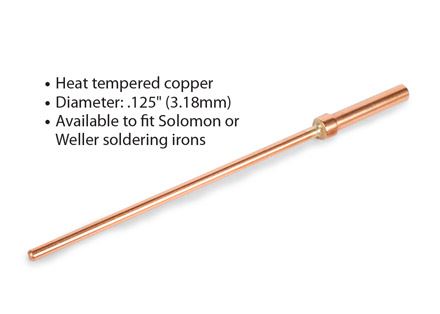
Instructions for separating a dovetail neck joint
The target for the HeatStick is a small gap in the neck joint, between the end of the neck and the neck block. This air gap occurs under the fret that is one fret in from the edge of the body, as shown below.

On many guitars, the neck meets the body at the 14th fret. This places the gap below the 15th fret, as shown in the illustration.
On some guitars, the neck meets the body at the 12th fret. On these, the gap will be below the 13th fret.
This fret will be removed, and a hole for the HeatStick will be drilled through the fret slot, into the air gap below. The HeatStick will be inserted through this hole to heat the neck heel and neck block, softening and releasing the glue.
Some guitars were built with no gap at the end of the dovetail joint. The HeatStick works with these cases just as well. It just takes a little more time for the HeatStick to work.
Loosen the fretboard extension
Use a heating iron and a thin flexible disassembly knife to separate the fingerboard from the instrument body. Mask off the surrounding guitar top to avoid scratching it, and work slowly and carefully to detach the fingerboard from the guitar top.

Remove one fret
Remove the first fret in from the edge of the body. Use a Fret Puller to avoid creating chips on the fingerboard.
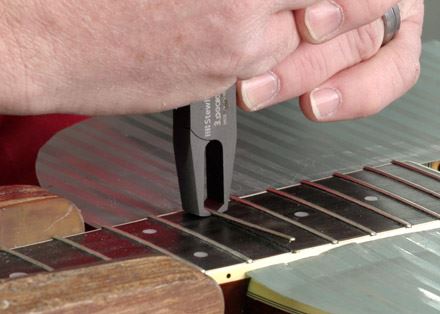
Drill a pilot hole
Using the smaller (3/32") bit provided, drill through the fret slot into the dovetail joint below. The center of your neck may contain a truss rod, so drill off-center by about 1/2".
The air gap may be directly below the fret slot, or could be slightly forward or back of the slot. It may be necessary to drill at a slight angle to reach it. A typical dovetail extends 5/8" past the point where the neck heel contacts the body.
If you don't reach an air gap, the HeatStick will work just as well, just taking a little longer to heat the area.
Drill at an angle, to hit the dovetail area instead of the neck block around it.
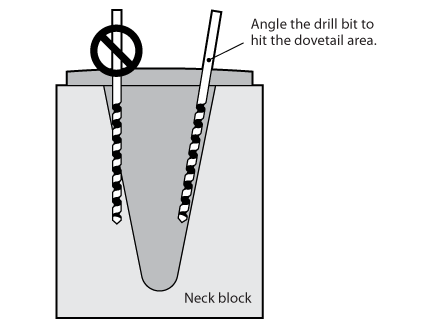
Drill the access hole
Once you have drilled the pilot hole, hopefully locating an air gap, switch to the larger (#27) drill bit provided. Before chucking this bit in your drill, add a piece of tape as a depth guide. Set a depth that will bring the tip of the bit to 3/4" from the bottom of the neck heel.

Use the #27 bit to enlarge the pilot hole, drilling at the same angle. Stop when the tape shows you've reached your depth.
Jig the guitar
Get the guitar ready for neck removal, using the Neck Removal Jig or other method. As the glue joint softens, you'll be carefully wiggling the neck to release it. Some prefer to clamp the body securely and move the neck, but you can also clamp the neck securely and move the body to separate the joint.
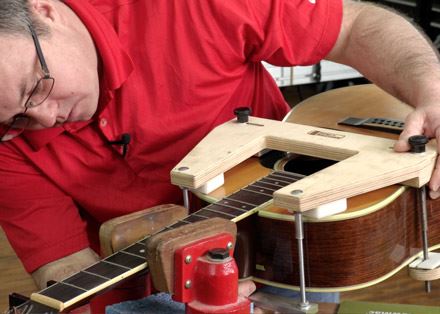
Preheat the HeatStick
Tighten the HeatStick in your soldering iron. If you are using an adjustable-heat soldering station, use the highest temperature setting. Let it heat to fully before inserting it into the neck joint.
Insert the HeatStick
Insert the HeatStick into the hole and begin heating the glue joint. After 5–10 minutes, test to see if the neck is loosening. Carefully working the neck from side-to-side, look for a slight separation of the neck from the body.
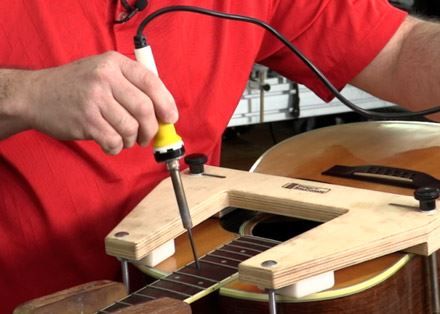
It helps to insert several drops of water into the access hole to help transmit the heat that softens the glue joint. Use a pipette, with about half a bulb of water, then re-insert the HeatStick.
Periodically, pull the HeatStick out and remove glue residue with a Chore Boy brass cleaning pad. Built-up glue will make the stick harder to remove.
Be patient and let the heat do its work. Most necks come out within 15–20 minutes—about 5–10 minutes longer for instruments with no air gap.
When you see a little movement, add another half pipette bulb of water through the access hole. You may need to add water a couple more times. Drops of water appearing at the bottom or sides of the neck heel are a good indication that the joint is loosening.
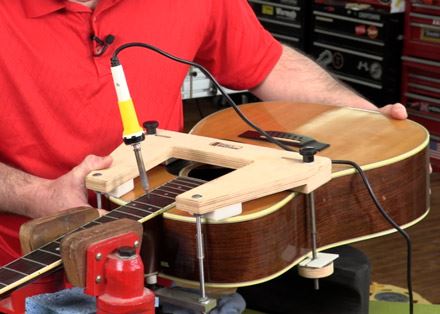
After the heat softens the glue in the neck joint, wiggle the neck and turn the pressure screw on the Neck Removal Jig to push the neck out of the joint. Continue heating throughout the removal. Don't force the neck out or you risk breaking the heel or part of the dovetail on the neck.

When the neck comes out, immediately turn off the soldering iron and remove the jig from the guitar body.
An alternate method for using the Neck Removal Jig is to clamp the guitar neck in your padded vise with the jig attached and the glue joint being heated. As the heat loosens the joint, gently work the body side to side as you tighten the pressure screw to push the neck out. Holding onto the guitar body instead of the neck gives you greater control in carefully and gradually working it back and forth as the glue joint loosens.
Removing tenon-style necks
The HeatStick can also be used for tenon necks like those found on Gibson Les Pauls or SGs. You can cut the HeatStick shorter to suit this application. These joints are very difficult to separate, with a lot of glued surface and no air gap. Many points of contact with the HeatStick are needed, resulting in many drilled holes to patch afterward.
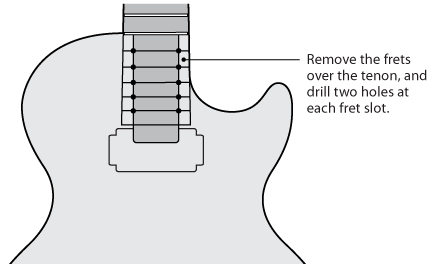
The target for the HeatStick is the glue joint along both sides of the tenon. One method is to pull all of the frets from the body joint to the end of the fretboard.
Identify the width of the tenon at the end of the neck, visible through the neck pickup cavity. Drill through each fret slot into the glue joint on each side of the tenon. Use the 3/32" pilot drill bit first, with a piece of tape as a depth guide. Be very careful not to drill through the body. When possible, measure and drill to the depth of the neck pickup cavity. If you don't have this as a reference, drill to within 3/8" of the back of the body.
After drilling pilot holes, switch to the larger #27 drill bit and drill to the same depth.
Separating a mandolin dovetail joint
Before removing a mandolin neck, you'll need to remove the fingerboard. Also remove the fingerboard extender block. The target for the HeatStick is the end of the dovetail joint, which may or may not have an air gap.
Use the 3/32" pilot drill bit first, with a piece of tape as a depth guide.
Be very careful not to drill through the body: don't drill deeper than to within 3/8" of the back of the body.
If there is no air gap to drill into, drill right on the glue joint at the end of the dovetail. After drilling pilot hole, switch to the larger #27 drill bit and drill to the same depth.


